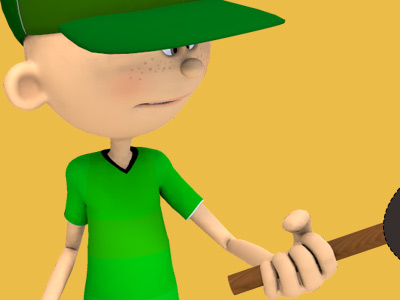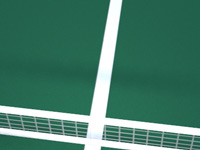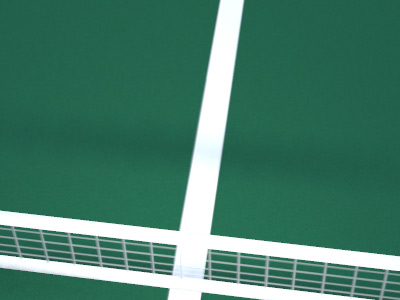Tennis

Strategy
Players use different tennis strategies to enhance their own strengths and exploit their opponent's weaknesses in order to gain the advantage and win more points.
Players typically specialize or naturally play in a certain way, based on what they can do best. Based on their style, players generally fit into one of three types: baseliners, volleyers and all-court players. Many players have attributes of all three categories but may focus on one style based on the surface or their opponent. A baseliner plays from the back of the tennis court, around the baseline, preferring to trade groundstrokes rather than to come up to the net (except in certain situations). A volleyer tries to approach the net and hit volleys, putting pressure on the opponent. All-court players fall somewhere in between.
A player's weaknesses may also determine strategy. For example, most players have a stronger forehand, therefore they will favor the forehand even to the point of "running around" a backhand to hit a forehand.
Baseliner strategies
Offensive or aggressive baseliner
At high levels of play, being an offensive baseliner requires consistently hitting deep shots, which land several feet back from the service line. The offensive baseliner may not try to win the point outright with one shot, but instead may hit the ball from side to side until he/she spots an opening. Offensive baseliners normally have at least one great groundstroke, forehand or backhand. The best offensive baseliners have a powerful and effective serve to go with a great groundstroke. Usually offensive baseliners (as well as defensive players) have the ability to anticipate the next shot very well and also their opponents' styles and tendencies.
An effective offensive baseliner can overpower many opponents. However, when going for winners, they can also produce many errors since they have to repeatedly and correctly execute some difficult strokes, such as down-the-line winners landing near the corner. Fatigue, loss of focus, mis-hitting the ball, and hesitating are some reasons for errors. Two great old-time players, R. Norris Williams and Ellsworth Vines, were famous for being unbeatable when their strokes were "on". However, they played with such little margin for error in making their strokes that when they were making more mistakes they could be beaten by other players. Another advantage of this strategy is that the player can weaken his opponent's confidence by successfully landing difficult shots which in turn may increase his own confidence.
Hard courts are generally considered to be the best surface for an offensive baseliner who often hit higher risk shots. However, offensive baseliners can often excel on both grass and clay courts as well. On grass, they can execute their "winners" and the fast, low bounce makes it harder for opponents to retrieve; whereas on clay courts, some offensive baseliners might like the slow and high bounce because it gives them a longer time to change their grip and foot-positions in order to set up for an offensive shot or winner. Offensive baseliners with height especially have an advantage on clay courts because the high bounces land in their hitting zones, allowing them to strike the ball cleanly and more powerfully. One great example for this is Maria Sharapova, who is 6'2", and the high bounce of the ball really helps her produce winners and force errors from her opponents. She had the hardest hit backhand at the 2013 French Open from the women's side, when she punished a first serve from Jelena Jankovic, producing a backhand return winner.
Rafael Nadal is accomplished at an Offensive Baseline playstyle, using a variety of high-spin shots and powerful flat strokes to dominate play, most notably on clay, which he is known to be very good at (though he usually prefers to play a defensive baseline style). Novak Djokovic, though known to be an all-rounder, is also a notable Aggressive Baseliner, with his powerful and precise backhand which is widely regarded as the best backhand of any active player.
Defensive baseliner
A defensive baseliner, or counter-puncher or retriever, tries to return every ball and relies on the opponent making mistakes. The trademarks of a counterpuncher include consistent shots with low error rate, as well as precise placement that makes it hard for their opponent to execute an aggressive shot. Counterpunchers also have a tendency to anticipate and are usually equipped with extremely good passing shots, thus enabling them to turn lots of defensive situations into offence. The game of the defensive counter-puncher has more to do with physical endurance and willingness to get every ball back in play as well as mental determination to keep from getting bored or trying for too much. Their game plan often involves moving their opponents back to the court and outmaneuvering their opponents. One example being former world number one Caroline Wozniacki who moves her opponent around the court without going for high risk winners. While on defence, she gets every ball back and constantly mixes up the pace, to frustrate her opponents.
While they tend to make relatively few errors because they do not attempt the complicated and ambitious shots of the aggressive baseliner, the effective counterpuncher must be able to periodically execute an aggressive shot, either using the pace given by their opponent or using precision and angle. Speed and agility are key for the counterpuncher, as well as a willingness to patiently chase down every ball to frustrate opponents. Returning every aggressive shot that the opponent provides is often the cause of further errors due to the effort required in trying increasingly harder and better shots. However, it is noted that for some faster players, including Gaël Monfils, Lleyton Hewitt and Andy Murray, standing too deep behind the court can hinder their attacking abilities.
At lower levels, the defensive counter-puncher often frustrates their opponent so much that they may try to change their style of play due to ineffective baseline results. At higher levels, the all-court player or aggressive baseliner is usually able to execute winners with higher velocity and better placement, taking the counterpuncher out of the point as early as possible.
Most counter-punchers often excel on slow courts, such as clay. The court gives them extra time to chase down shots and it is harder for opponents to create winners. However, some counter-punchers who have the ability to mix up their game and turn defense into offense, like Lleyton Hewitt and Andy Murray, have excelled on faster courts like hard and grass as well as slower courts. Counter-punchers are often particularly strong players at low-level play, where opponents cannot make winners with regularity.
Serve-and-volleyer
A serve and volleyer has a great net game, is quick around the net, and has fine touch for volleys. Serve and volleyers come up to the net at every opportunity when serving. They are almost always attackers and can hit many winners with varieties of volleys and drop volleys. When not serving, they often employ the "chip-and-charge", chipping back the serve without attempting to hit a winner and rushing the net. The serve-and-volleyers' strategy is to put pressure on the opponent to try to hit difficult passing shots. This strategy is extremely effective against pushers.
Serve-and-volleyers benefit from playing on fast courts, such as grass or fast concrete. The quick bounce and faster pace of play give them an advantage because opponents have less time to set up for a passing shot. However, the number of serve-and-volley players is decreasing in today's professional tennis, because this strategy requires more experience to master and defeat other playing styles (as well as changes in racquet technology that have improved players' passing shots). In addition to this, there has been a trend toward the slowing down of tennis surfaces over the past few years. The serve-and-volley technique works better on faster surfaces because the volleyer is able to put more balls away without the baseliner being able to chase them down. Although serve and volleyers may be a dying breed, there are still some great players who employ this tactic. The Frenchman Michaël Llodra has been considered by many to be the best pure serve and volleyer of today's game.
All-court player
All-court players, or all-rounders, have aspects of every tennis style, whether that be offensive baseliner, defensive counter-puncher or serve-and-volleyer. All-court players use the best bits from each style and mix it together to create a truly formidable tennis style to play against. In game situations, they have the ability to select an action usually executed by one tennis style. They usually have an attacking game, mixing some groundstrokes and volleys to keep the opponent guessing. Most all-court players won't rush the net immediately after a serve like a typical serve and volley player would. However, their game often revolves around "constructing" a point to where they will be able to approach the net and put away an easy volley or pulling their opponent into the net and hitting a passing shot.
They are very versatile; when an all-court player's baseline game is not working, he/she may switch to a net game, and vice versa. All-court players have the ability to adjust to different opponents that play different styles easier than pure baseliners or serve and volleyers. All-court players typically have the speed, determination and fitness of a defensive counter-puncher, the confidence, skill and flair of offensive baseliners and have the touch, the agility around the net and tactical thinking of the serve-and-volleyer.
However, just because the all-court player has a combination of skills used by all tennis styles does not necessarily mean that they could beat an offensive baseliner or a defensive counter-puncher or even a serve-and-volleyer. It just means it would be more difficult to read the game of an all-court player.
Roger Federer has been hailed by many critics, commentators, former and current players, and analysts as the greatest all-court player of all time.
Serving strategy
Holding serve is crucial in tennis. To hold serve, serves must be accurately placed, and a high priority should be placed on first serve percentage. In addition, the velocity of serve is important. A weak serve can be easily attacked by an aggressive returner. The first ball after the serve is also key. Players should serve in order to get a weak return and keep the opponent on the defense with that first shot. For example, following a wide serve, it is ideal to hit the opponent's return to the open court. There are three different types of serves and each one of them can be used in different situations. One type of serve is the serve with slice. The slice serve works better when the player tosses the ball to the right and immediately hits the outer-right part of the ball. This serve is best used when you hit it wide so you get your opponent off the court.
Another type is the kick serve. To achieve a good execution, the player must toss the ball above the head and immediately spin the bottom-left part of the ball. Since the ball is tossed above the head, it is necessary for the player to arch correctly under the ball. This serve is best used as second serve because the amount of spin that is added to the ball makes it very safe. The kick serve is also effective when a change of rhythm is needed or when the opponent struggles with the high bounce that results from the effect.
A third type of serve is the flat one. To execute this serve, the player must toss the ball right in front and immediately hit the middle-top part of the ball. This is usually a very hard serve and therefore risky. However, if the flat serve is executed with enough power and precision, it can turn into a great weapon to win points faster.
Doubles strategy
Though strategy is important in singles, it is even more important in doubles. The additional width of the alleys on the doubles court has a great effect on the angles possible in doubles play. Consequently, doubles is known as a game of angles.
There are three basic doubles strategies:
- both-up strategy (also called "two-up" strategy)
- up-and-back strategy (also called "one-up/one-back" or "I" strategy)
- both-back strategy (also called "two-back" strategy)
Both-up strategy
The ideal is both-up strategy, often called "Attacking Doubles" because the net is the "high ground", and the both-up strategy puts both players close to it, in a position to score because of their excellent vantage points and angles. A team in the both-up formation, however, is vulnerable to a good lob from either opponent at any time. To be successful with Attacking Doubles, teams must have effective serves and penetrating volleys to prevent good lobs and good overhead shots to put away poor returns.
Teams that play attacking doubles try to get into the both-up formation on every point. When serving, their server follows most first serves to the net and some second serves. As a result, attacking doubles is also called serve-and-volley doubles. When receiving, their receiver follows most second-service returns to the net.
At the professional level, attacking doubles is the standard strategy of choice.
Up-and-back strategy
At lower levels of the game, not all players have penetrating volleys and strong overhead shots. So, many use up-and-back strategy. The weakness in this formation is the large angular gap it creates between partners, a gap that an opposing net player can easily hit a clean winner through if they successfully poach a passing shot.
Nonetheless, up-and-back strategy is versatile, with elements of both offense and defense. In fact, since the server must begin each point at the baseline and the receiver must be far enough back to return the serve, virtually every point in doubles begins with both teams in this formation.
Teams without net games strong enough to play Attacking Doubles can still play both-up when they have their opponents on the defensive. To achieve this, a team would patiently play up-and-back for a chance to hit a forcing shot and bring their baseliner to the net.
Australian Doubles and the I-Formation are variations of up-and-back strategy. In Australian doubles, the server's partner at net lines up on the same side of the court, fronting the opposing net player, who serves as a poaching block and blind. The receiver then must return serve down the line and is liable to have that return poached. In the I-Formation, the server's net partner lines up in the center, between the server and receiver so he or she can poach in either direction. Both Australian Doubles and the I-Formation are poaching formations that can also be used to start the point for serve-and-volley doubles.
Both-back strategy
Both-back strategy is strictly defensive. It is normally seen only when the opposing team is both-up or when the returner is passing the net player on the return. This might be a good tactic when the opponent has a serve with a lot of pressure and an aggressive player at the net. From here the defenders can return the most forcing shots till they get a chance to hit a good lob or an offensive shot. If their opponents at net become impatient and try to angle the ball away when a baseliner can reach it, the defender can turn the tables and score outright. However this strategy leaves the volley court open to drop shots from the opposition.
SPORTS

RESOURCES
This article uses material from the Wikipedia articles "Tennis" and "Tennis strategy", which is released under the Creative Commons Attribution-Share-Alike License 3.0.
© Stories Preschool. All Rights Reserved.









